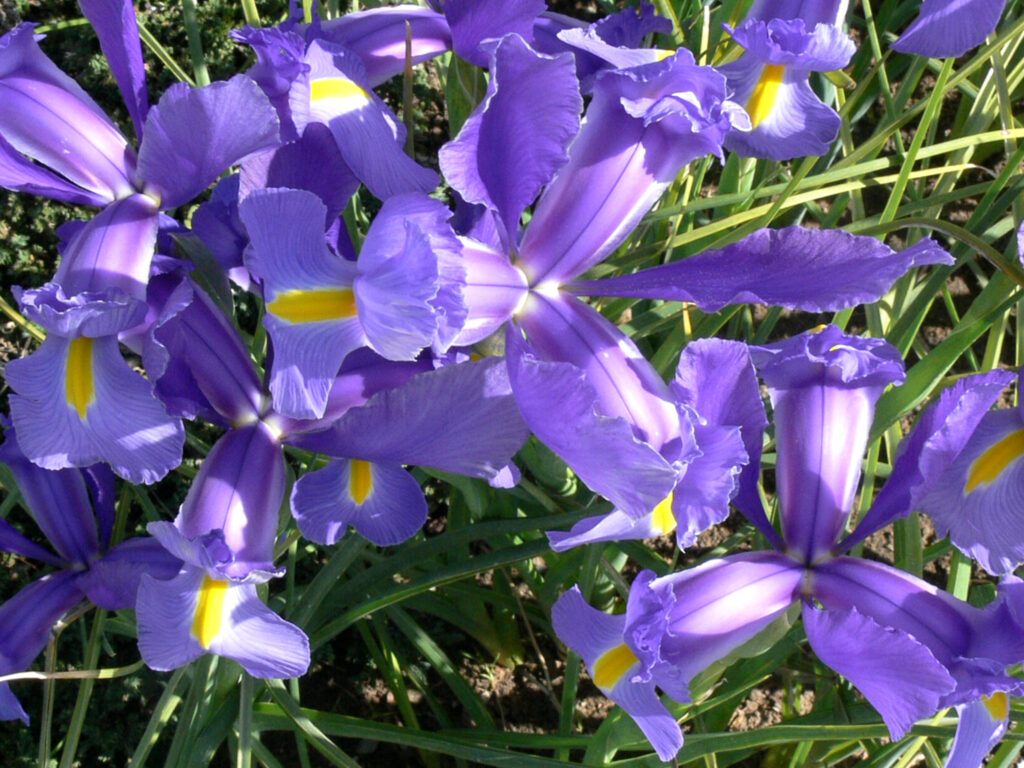The Iris is a gorgeous flower. It’s named after Iris in Greek mythology, the goddess of the rainbow, because these flowers come in so many beautiful colors. They were cultivated in ancient Greece, ancient Egypt, Asia, and the Mediterranean for thousands of years. There are varieties native to Asia, Europe, and the Americas. The Iris is associated with the Fleur de Lys of France (as is the lily) and the Iris is the state flower of Tennessee. They became commonly cultivated in Europe in the 1500s, and some were imported to the Americas (Virginia) as early as the 1600s.
The Different Iris Species
There are literally hundreds of different species of Iris. Irises grow from rhizomes, which are longish thick root-like tubers that grow (and should be planted) on or near the surface of the soil. Structurally they are part of the stem of the plant, but they store nutrients and even some moisture so the plant will rebloom once planted. There are basically two main types.

The first is rhizomatous Iris. On these, the root structure (the rhizome) resembles a piece of stem with roots coming out of the bottom. They are the most common, and the German “bearded iris” is in this group. The second type is called bulbous Iris, or just “iris bulbs.” Though still technically rhizomes, they are most commonly just called bulbs, even by professional gardeners, and are recognized as a different type of Iris. Reticulata and Dutch Iris have several varieties of iris bulbs. The bulb types will be smaller plants, and they are just as beautiful.
- Iris
- Perennial
- Full sun
- Fertile, well-draining soil, neutral to slightly acidic (6.8-7.0pH)
- Indoor start instructions
- Plant from late summer to early fall.
- 24” apart
- Growing in containers:
Flowers can be grown in containers with some care
Large pots – at least 12” wide for larger Iris, 8” wide for dwarf varieties
Plant on the surface, and ensure good drainage, and water frequently.
- Watering/care info
- Climate Zones 3-9 for Siberian Iris and Japanese Iris, 5-9 for most others
Planting Iris
Iris rhizomes should be planted in soil that drains very well, and autumn planting is best. It is important to avoid overly soggy soil since that can lead to disease. They do best in soil that is moist but not muddy. Pick a location that will get plenty of sun. Plant the rhizomes or bulbs about 6 weeks before the first frost in fall to let them get established. Dig and loosen the soil in the area where the iris will be planted, in a wide area about 6 inches deep, and mix in compost. Dig a large shallow hole, 8-10 inches wide, and 3-4 inches deep. Clump up some dirt in the center, and spread the roots over that to keep them a bit separated. Fill in the hole, covering the rhizome and leaving the very top of it just peeking out above the surface. Don’t cover them completely, they need to be just at the surface. Plant singly or in groups, but keep each plant about 24 inches apart. Water well, keeping them moist after first planting. If dividing existing irises, they can be planted any time during the season, it’s not necessary to wait, but they will likely not bloom until the next spring or summer. Don’t plant sooner than about 2 weeks after the last frost in spring.
It is best to leave existing iris rhizomes in the ground, rather than removing them for storage over the winter. In warmer climates when the temperatures are low 50s °F or higher, it’s best to water them occasionally, but don’t water in areas with colder winters. Irises are pretty resistant to frost. Established plants can withstand sub-zero temperatures pretty well, but if there is an icy hard freeze (-25°F or colder), it’s best to try and insulate them a bit, with straw or leaves.
Iris are great as potted plants too. The main thing to remember is to get a pot that is extremely wide. 12 inches wide and 8 inches deep is a good size for a single plant, but bigger is better. If you want to plant multiple flowers in one pot, get one at least 24″ across, and still 8 inches deep, and plant 2 plants, on opposite sides of the container. This allows enough room for the roots, which are shallow but spread widely. As you might guess, a potted Iris needs a pot that drains very well.

Caring for Iris
When watering, ensure the soil is completely moist. Water until it starts to drip from the drain holes. In very hot and dry weather, water more often. Fertilization is needed for potted irises twice a year. First in spring at the start of the growing season, and then again after they have fully bloomed. In the winter, it is usually best to store the plants indoors, in a cool area like an unheated garage. The plants need a cooler period to allow the rhizomes to go dormant in preparation for spring. Irises don’t have the protection from bitter cold in pots that they do when planted in the ground.
Iris Companion Planting
There are a number of flowers and shrubs that are great companion plants for irises. Usually, companion plants are chosen for nutritional value, or help with resistance to pests. Flower companions for Iris are chosen for the times that they bloom. Many irises bloom early in the spring, so it’s common to plant things like violets, daffodils, and peonies, as well as lilacs and daisies that bloom a bit later so that they will brighten up the garden as the iris fades. Other flowers like daylilies, lavender, and even echinacea will bloom and enhance the colors. Lavender does also have the advantage of attracting ladybugs, which can help repel aphids from the garden.

Iris Pests and Diseases
Aphids are a known pest of the iris, as are thrips, but one specific pest that can cause issues in the eastern US is the Iris Borer. Iris borers are small pink caterpillars that will become moths when they are mature. The main issue with these creatures is that they will chew their way into an iris bulb or rhizome, and once inside, they are hard to detect. The rhizome will start to decay and rot from the inside. They will eat holes in the leaves, and the leaf appearance will change, with dark stripes appearing. The edges will become ragged. Insecticide is an effective treatment, but nematodes are an insect that kills borers, and these can be released into the garden.
Diseases that affect the iris include fungal diseases like leaf spot and rust, and mosaic virus. and botrytis (a mold infection). Rot from iris borers can also trigger a severe infection, and a severe infection from any source means that the entire plant will need to be dug up and removed, and disposed of away from the garden. Most diseases can be prevented by spacing the plants correctly, weeding, and avoiding overhead watering.
New iris flowers are generally produced by carefully splitting the rhizome. Carefully break the rhizome by hand at a joint, and ensure both sides have plentiful roots. Each part can be replanted separately in the fall. This will ensure that the plant will grow into the same variety. Iris can be grown from seed as well. Since most Iris are hybrids, there isn’t a perfect way to predict what specific appearance will be of an iris produced by seed. They are likely to still be very pretty but differ in some ways from the parent plant.
Planting Iris from Seed
The plants do produce seed pods that turn brown when they are ready to split. It’s a good idea to break off the pods and allow the seeds to dry for a few months. Plant them in the garden, in a spot set aside for them in late fall (October is a good bet). Space them about 1 inch apart, and plant them about 1/2 to 3/4 inches deep. Allow them to stay in the ground over the winter. When spring comes, carefully dig them up, and replant them at the usual distance of about 24 inches apart. This will allow them to grow fully, and see how they do. It’s a good idea to keep a good record of the type of plant each seed came from. Any plants grown from seeds that grow healthy and strong with unique beautiful flowers should be preserved and developed for a year or two, then the rhizomes can be split to create new plants of the same kind.
This is a super easy-to-grow and beautiful flower that is a great perennial and will beautify your garden every spring!









